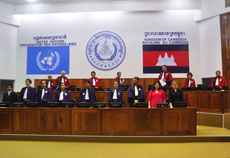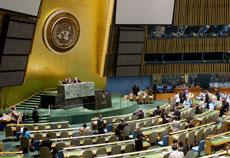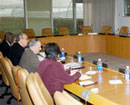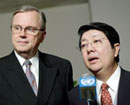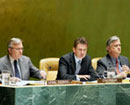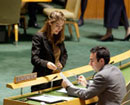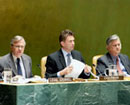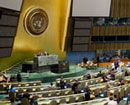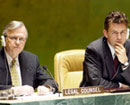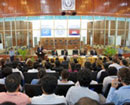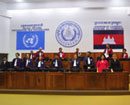|
Agreement between the United Nations and
the Royal Government of
Cambodia concerning the prosecution under Cambodian law of crimes committed during the period of Democratic Kampuchea Phnom Penh, 6 June 2003
The Historical Context
The genesis of the agreement between the United Nations and Cambodia was a letter to then Secretary-General Kofi Annan dated 21 June 1997 from the two Prime Ministers of the Royal Government of Cambodia in which they asked “for the assistance of the United Nations and the international community in bringing to justice those persons responsible for the genocide and crimes against humanity during the rule of the Khmer Rouge from 1975 to 1979”. The letter also contained the following clarification: “We are aware of similar efforts to respond to the genocide and crimes against humanity in Rwanda and the former Yugoslavia, and ask that similar assistance be given to Cambodia.” The Secretary-General transmitted the letter to the Presidents of the General Assembly and of the Security Council on 23 June 1997 (A/51/930-S/1997/488). The response came from the General Assembly. In its resolution 52/135 of 12 December 1997 the Secretary-General was asked to examine the request, including the possibility of appointing a group of experts to evaluate the existing evidence and to propose further measures. On 13 July 1998, the Secretary-General appointed a Group of Experts to evaluate the existing evidence, assess the feasibility of bringing Khmer Rouge leaders to justice and explore options for doing so before an international or national jurisdiction. Before going into the details of the work of the Group of Experts and its proposal, it is important to focus on the situation in Cambodia during the Khmer Rouge rule from 1975 to 1979. The following is a summary of the analysis by the Group of Experts in its report (A/53/850-S/1999/231). On 17 April 1975, Phnom Penh fell to the forces of the Communist Party of Kampuchea, commonly known as the Khmer Rouge. The Khmer Rouge’s armed struggle against the government in Phnom Penh had begun in the late 1960s and had accelerated after a coup in March 1970 that overthrew the Head of State, Prince Norodom Sihanouk, and replaced him with a new regime, under the name of the Khmer Republic. From 1975 to 1979 the Khmer Rouge committed atrocities through deliberate policies of the Communist Party of Kampuchea. The Party proclaimed its victory as ending 2,000 years of subjugation of the Khmer peasantry at the hands of foreign and class enemies. But it continued to see these enemies as an all-pervasive threat to the regime and its dream of a fully independent and socially and ethnically homogeneous Cambodia. To counter the perceived threat and build a “clean social system”, the regime launched a uniquely thorough revolution whereby all pre-existing economic, social and cultural institutions were abolished, all foreign influences were expunged and the entire population was transformed into a collective workforce, required to work at breakneck speed to build up the country’s economic strength. Meanwhile, the regime acted ruthlessly against all elements suspected of being hostile to the new order. This included those with links to foreign countries, in particular Viet Nam. In April 1976, a new constitution and new state organs were announced, and the country was renamed Democratic Kampuchea. To exercise control over the country, the Communist Party of Kampuchea divided it into zones, which were in turn divided into sectors. Below the sectors lay districts, sub-districts, and cooperatives. Every member of the population was incorporated into an administrative or functional unit led by a committee appointed by the Communist Party of Kampuchea, with most of the population organized into agricultural cooperatives. The centre in Phnom Penh set policy through numerous directives to regional and local officials. Most notably, these directives set the country’s basic economic policies and dictated the various purges of elements deemed anti-revolutionary that characterized Democratic Kampuchea. When Phnom Penh learned that cadres were not implementing its directives or that those policies were failing to remedy the country’s problems (most notably in terms of food production), it responded with purges of many thousands of its own officials. The years of Democratic Kampuchea were marked by abuses of individual and group human rights on an immense and brutal scale. For purposes of their report, the Group of Experts grouped them into four categories: (1) Forced population movements, (2) Forced labour and inhumane living conditions, (3) Attacks on enemies of the revolution, and (4) Purges within the Communist Party of Kampuchea. Forced population movements: The first priority of the new leadership upon taking power was the forced evacuation of all cities and towns of Cambodia. In the week following its victory, the Government forced 2 to 3 million people out of these areas and into the countryside, sparing neither the aged, sick nor very young. It is believed that many thousands, especially among the aged and the young, died from lack of food, water, and medical assistance during forced marches to the countryside. Forced labour and inhumane living conditions: The economic system implemented nationwide by the Government of Democratic Kampuchea relied on forced labour. The former town-dwellers joined the rural population in agricultural cooperatives which, by the end of the regime, were intended to embrace entire districts. Cambodians were put onto work teams, often under armed supervision, and forced to grow rice and other crops or construct large-scale infrastructure projects. Work hours were long, often beginning before dawn and continuing into the night, seven days a week; food rations proved meagre as the country suffered shortages. Starvation, disease, and physical exhaustion, caused by overwork and inadequate food, medicine and sanitation, killed hundreds of thousands. Attacks on enemies of the revolution: The regime also targeted certain groups for extermination by virtue of their imputed political beliefs or social or ethnic background. Without recourse to any formal judicial system, virtually every unit of the regime appears to have had the right, even the duty, to identify, detain and execute those believed to be enemies. Former government leaders, military officers and bureaucrats of the Khmer Republic were immediately targeted for elimination. During the first few months of the regime, thousands were summarily executed, either individually or in large round-ups. The Cham, a Muslim sect present in Cambodia for 500 years, were forcibly dispersed, had their language and customs banned and saw their leaders and others resisting governmental policies killed. Ethnic Chinese sometimes faced special discrimination. As did the Vietnamese, many of whom had lived in Cambodia for generations and played an important role in the Cambodian economy. Most were expelled in 1975. When identified through trickery or other means, teachers, high school students and professionals were often killed. Cambodians with foreign language proficiencies or ties to foreign countries were considered spies and also killed. Whatever cosmopolitanism had existed in Cambodia’s cities disappeared over the next three years. In overturning the structures of Khmer society, the Government also aimed its sights at organized religion, including Buddhism, the religion of most Khmers. The regime forced monks to leave the priesthood, killing those who refused. It destroyed numerous Buddhist temples and converted others into storage areas or even prisons, obliterating many sacred objects and texts in the process. As a result, the entire organized priesthood in the country was disbanded. The Government also destroyed hundreds of mosques and many churches. Purges within the Communist Party of Kampuchea: The paranoia of the Khmer Rouge regime showed itself most clearly in the treatment of its own cadres. In an ever-expanding purge beginning in late 1976 and continuing until the overthrow of the regime, the leadership looked for enemies within the Party, accusing them of being agents of the CIA, KGB or of Viet Nam. This process involved not only the execution of suspected individuals within the leadership of each unit (including many members of the Government and the Central Committee of the Party), but also the repeated wholesale arrest and killing of all of the Party cadres in a unit considered treacherous, such as a particular sector or military division. One such attempted purge of the eastern zone in May 1978, led to the largest of several local insurrections during the regime. Military elements in the eastern zone, which borders Viet Nam, rebelled against the capital, leading to prolonged fighting from June through September 1978. The battle was characterized by major human rights abuses by government forces, who may have killed at least 100,000 people in the region, many of them local civilians whom it regarded as having “Khmer bodies with Vietnamese minds”. Party cadres, their families and villagers were exterminated. Hundreds of thousands of others were evacuated to points north and west where they died of starvation and disease or were later murdered. The final observation by the Group of Experts with respect to this period is that scholars and Governments had offered differing totals for the number of Cambodians killed by the Khmer Rouge. Scholars had separately arrived at figures of 1.5 million and nearly 1.7 million. There was a sharp disparity among victim groups. One study posed it close to a 100 per cent death rate for rural and urban ethnic Vietnamese, 25 per cent for urban and rural Khmer “new people”, and 15 per cent for rural Khmer “base people”. Overall, the various estimates pointed to a death rate of approximately 20 per cent of the April 1975 population of 7.3 to 7.9 million people. Historians of Cambodia had rejected the figure of 2 to 3 million that had often been used by the Governments in Cambodia since 1979, as well as in some popular accounts. In paragraphs 36 to 41 of the report of the Group of Experts there is a description of the manner in which the Khmer Rouge gradually lost power, starting with the invasion of Phnom Penh on 6 January 1979 by an opposition group supported by Viet Nam and ending with the law passed by the national legislature on 7 July 1994 outlawing the Khmer Rouge. The Negotiating History
In accordance with General Assembly resolution 52/135, the Secretary-General created the Group of Experts for Cambodia in July 1998 with the following mandate:
The Secretary-General appointed, as members of the Group, Sir Ninian Stephen (Australia), who was the Chair of the Group, Judge Rajsoomer Lallah (Mauritius) and Professor Steven R. Ratner (United States of America). By letters dated 31 July 1998, the Secretary-General informed the President of the General Assembly, the President of the Security Council and the first and second Prime Ministers of Cambodia of the formation of the Group, its mandate and composition. The Group’s work was conducted in three stages: legal and historical research on the issues related to its mandate; consultations and meetings with a wide variety of officials from Governments, international organizations and non-governmental organizations; and deliberation and preparation of its report. The bulk of the consultations and meetings took place during two missions of the Group: to the United Nations Headquarters from 7 to 11 September 1998; and to Phnom Penh and Bangkok from 14 to 24 November 1998. In addition, individual members of the Group held meetings with persons whose views were considered important to the work of the Group and the Group met at the Office of the United Nations High Commissioner for Human Rights in Geneva from 27 to 29 January 1999 to finalize its recommendations. After a thorough analysis of the issues assigned to the Group, it presented the following summary of its principal recommendations: “1. We recommend that, in response to the request of the Government of Cambodia of 21 June 1997, the United Nations establish an ad hoc international tribunal to try Khmer Rouge officials for crimes against humanity and genocide committed from 17 April 1975 to 7 January 1979. 2. We recommend that, as a matter of prosecutorial policy, the independent prosecutor appointed by the United Nations limit his or her investigations to those persons most responsible for the most serious violations of international human rights law and exercise his or her discretion regarding investigations, indictments and trials so as to fully take into account the twin goals of individual accountability and national reconciliation in Cambodia. 3. We recommend that the Security Council establish this tribunal or, should it not do so, that the General Assembly establish it. 4. We recommend that the tribunal comprise two trial chambers and an appellate chamber and that the United Nations actively seek to include on the tribunal a Cambodian national whom it believes is qualified, impartial and appropriate. 5. We recommend that the Prosecutor of the International Tribunal for the Former Yugoslavia and of the International Criminal Tribunal for Rwanda serve as the Prosecutor of the new tribunal, with a Deputy Prosecutor specifically charged with responsibility for this tribunal. 6. We recommend that the tribunal, including the office of the Deputy Prosecutor, be established in a State in the Asia-Pacific region, but not in Cambodia; that the Prosecutor establish an investigations office in Cambodia; and that the United Nations, in cooperation with the Government of Cambodia, arrange for the unfettered dissemination of the proceedings in Cambodia by radio and television. 7. We recommend that the full panel of judges appointed by the United Nations not commence full-time service until at least some indictees have been arrested. 8. We recommend that the United Nations undertake special measures for the protection of physical evidence and of witnesses as necessary, and that States with evidence and witnesses on their territory make them available to the Prosecutor. 9. We recommend that the tribunal established provide for the possibility of reparations by defendants to victims, including through a trust fund or some other special fund, and that States holding such assets arrange for their transfer to the tribunal as required to meet the defendants’ obligations in this regard. 10. We recommend that the United Nations, in cooperation with the Cambodian Government and the non-governmental sector, encourage a process of reflection among Cambodians to determine the desirability and, if appropriate, the modalities of a truth-telling mechanism to provide a fuller picture of the atrocities of the period of Democratic Kampuchea.” The final paragraph in the report dated 18 February 1999 reads: “220. In asking for United Nations assistance, the Government of Cambodia has responded to what we sense is the desire of the Cambodian people for justice and their knowledge that it is impossible to simply ignore the past. Rather, it is necessary to understand the past and move beyond it by seeing justice done for those responsible for it. This process has been too long delayed for Cambodia and the time for action is here. If these and our other recommendations are pursued by the United Nations now, with the support of the Government of Cambodia, we believe they will lead to a process that will truly enable Cambodia to move away from its incalculably tragic past and create a genuine form of national reconciliation for the future.” This option was, however, not acceptable to the Government of Cambodia. Instead then Prime Minister Hun Sen wrote to the Secretary-General once more, asking the United Nations to provide experts to assist Cambodia in drafting legislation that would provide for a special national Cambodian court to try Khmer Rouge leaders and that would provide for foreign judges and prosecutors to participate in its proceedings. In response to that request, the Secretary-General entered into negotiations with the Government of Cambodia with a view to reaching agreement on how such a court would have to be organized and how it would have to function, if the United Nations was to provide or arrange assistance to help establish it and help it to function. It fell upon me to represent the United Nations in those negotiations. Cambodia was represented by Deputy Prime Minister Sok An. These negotiations became extraordinarily complex for the simple reason that Cambodia reiterated that the operation should be governed by their national law instead of an agreement between the United Nations and Cambodia based on international law. The first meeting took place in Phnom Penh in August 1999, where the United Nations delegation was led by my deputy, Mr. Ralph Zacklin. At the same time the Cambodian Government was preparing national legislation, which in their view should be adopted before there was an agreement between the parties. The August meeting was followed by several letters between me and Deputy Prime Minister Sok An and also between the Secretary-General and Prime Minister Hun Sen. The Secretary-General also discussed the matter when he met with Prime Minister Hun Sen at international conferences, including a conference in Cuba in April 2000, where also United States senator John Kerry who was engaged in the matter was present. These contacts led to another meeting in Phnom Penh in July 2000, during which Deputy Prime Minister Sok An and a United Nations delegation led by me discussed a draft agreement. In parallel, Cambodia developed the draft national legislation which was adopted in 2001 in spite of the fact that usually an agreement between a State and the United Nations would require that the parties had signed an agreement and that this had been ratified. National legislation is then adopted to implement the ratified agreement. The parties ultimately could not agree on important issues. The United Nations’ fundamental requirement was that an agreement be signed to establish binding conditions for the court’s operation. The Cambodian government asserted that domestic law passed by its Parliament establishing the court should be the final word. Because the domestic law could be changed by the Parliament at any time, there was a concern that there might be no guarantees against delays or political influence. After two and a half years, the negotiations came to an end. During that time, I had also been heading the United Nations delegation in the negotiations with Sierra Leone for the establishment of the Special Court for Sierra Leone. It was partly against this background that, in February 2002, Secretary-General Kofi Annan concluded that he was no longer in a position to continue the negotiations with Cambodia. However, the main reason for this withdrawal was the Secretary-General’s concern that throughout the previous negotiations, the Government of Cambodia had exhibited a lack of urgency, together with an absence of the active and positive commitment to the process that would be essential when it came to implementing any agreement and to establishing the Extraordinary Chambers in the Courts of Cambodia making them operational and ensuring their sustained operation. The withdrawal caused concern among Member States, and there were further discussions in 2002 culminating in General Assembly resolution 57/228 of 18 December 2002, from which the following passages could be quoted: “Welcoming the efforts of, and the substantial progress made by, the Secretary-General and the Government of Cambodia towards the establishment of Extraordinary Chambers within the existing court structure of Cambodia (hereinafter referred to as Extraordinary Chambers), with international assistance, for the prosecution of crimes committed during the period of Democratic Kampuchea, Welcoming in particular the promulgation of the Law on the Establishment of the Extraordinary Chambers in the Courts of Cambodia for the Prosecution of Crimes Committed during the Period of Democratic Kampuchea, and noting with appreciation the general provisions and competence of the Law and its provision for a role for the United Nations, Noting the statements of the Secretary-General on 8 February and 20 August 2002 concerning negotiations between the Secretary-General and the Government of Cambodia on the establishment of the Extraordinary Chambers, Welcoming the subsequent discussions between the Secretary-General and the Government of Cambodia on the establishment of the Extraordinary Chambers, Welcoming also the Joint Communiqué of the thirty-fifth Ministerial Meeting of the Association of South-East Asian Nations, held in Brunei Darussalam on 29 and 30 July 2002, which, inter alia, expressed support for the continued efforts of the Government of Cambodia to bring the senior leaders of Democratic Kampuchea and those most responsible for serious crimes committed to trial in accordance with international standards of justice, fairness and due process of law and recognized the need for the Government of Cambodia and the United Nations to cooperate in this regard, Desiring that the international community continue to respond positively in assisting efforts to investigate the tragic history of Cambodia, including responsibility for past international crimes such as acts of genocide and crimes against humanity committed during the regime of Democratic Kampuchea, 1. Requests the Secretary-General to resume negotiations, without delay, to conclude an agreement with the Government of Cambodia, based on previous negotiations on the establishment of the Extraordinary Chambers consistent with the provisions of the present resolution, so that the Extraordinary Chambers may begin to function promptly; 2. Recommends that the Extraordinary Chambers should have subject-matter jurisdiction consistent with that set forth in the Law on the Establishment of the Extraordinary Chambers in the Courts of Cambodia for the Prosecution of Crimes Committed during the Period of Democratic Kampuchea; 3. Recommends also that the Extraordinary Chambers should have personal jurisdiction over the senior leaders of Democratic Kampuchea and those who were most responsible for the crimes referred to in paragraph 2 above; 4. Emphasizes that the arrangements for the establishment of Extraordinary Chambers, as devised in particular by the Royal Government of Cambodia, should: (a) Ensure that the Extraordinary Chambers exercise their jurisdiction in accordance with international standards of justice, fairness and due process of law, as set out in articles 14 and 15 of the International Covenant on Civil and Political Rights; (b) Include arrangements for an appellate chamber; 5. Also emphasizes the importance of ensuring the impartiality, independence and credibility of the process, in particular with regard to the status and work of the judges and prosecutors; 6. Appeals to the Government of Cambodia to ensure that persons referred to in paragraph 3 above are brought to trial in accordance with international standards of justice, fairness and due process of law, as referred to in paragraph 4 above, and notes the assurances of the Government of Cambodia in this regard;” The resumption of the negotiations between the United Nations and the Government of Cambodia in accordance with the resolution took place in two stages. The first stage consisted in a series of six exploratory meetings, held at United Nations Headquarters in New York between 6 and 13 January 2003. As in the past, the delegations were led by Mr. Sok An and me. With reference to paragraph 1 of the resolution, the Secretary-General understood that, to be consistent with the terms of the resolution, any agreement between the United Nations and the Government of Cambodia would have to satisfy seven specific conditions, enumerated in paragraph 10 of the Report of the Secretary-General on Khmer Rouge trials (A/57/769). In the light of these conditions, it was the Secretary-General’s understanding that resumed negotiations should be based upon, and to take as the point of departure, the draft agreement which had been under discussion during the course of the previous negotiations between the United Nations and the Government of Cambodia, which had come to an end on 8 February 2002. At the same time, it was also his considered view that the General Assembly had given him a clear and unambiguous mandate to negotiate for an agreement that would incorporate certain changes to that draft. In paragraph 16 of the Report of the Secretary-General on Khmer Rouge trials, there is a detailed description of the proposals that the Secretary-General advanced during the exploratory meeting in New York. The position of the Cambodian delegation is described in paragraph 17 of the Report. The second stage of the resumed negotiations took place in Phnom Penh from 13 to 17 March 2003. These negotiations resulted in a draft agreement initialled by Mr. Sok An and me on 17 March 2003. The draft is annexed to the Report of the Secretary-General on Khmer Rouge trials, which also contains a description of the negotiations and detailed explanations to many of the matters discussed and the reason for the manner in which they were resolved. Taking note of the report of the Secretary-General, the General Assembly approved the draft agreement in its resolution of 13 May 2003 (A/57/228B). On 6 June 2003, the agreement was signed in Phnom Penh. The agreement entered into force on 29 April 2005 in accordance with its article 32 after both parties had notified each other in writing that the legal requirements for entry into force had been complied with. The process of establishing the Extraordinary Chambers in the Courts of Cambodia became a complex procedure, and the court could not begin its operations until 2007. A summary of key provisions appears in the Report of the Secretary-General on Khmer Rouge trials. This Introductory Note was written in September 2020.
Related Materials A. Legal Instruments
Agreement between the United Nations and the Royal Government of Cambodia concerning the prosecution under Cambodian law of crimes committed during the period of Democratic Kampuchea, Phnom Penh, 6 June 2003, United Nations, Treaty Series, vol. 2329, p. 117. B. Documents
Identical letters dated 23 June 1997 from the Secretary-General to the President of the General Assembly and the President of the Security Council (A/51/930-S/1997/488). General Assembly resolution 52/135 of 12 December 1997 (Situation of human rights in Cambodia). Identical letters dated 15 March 1999 from the Secretary-General to the President of the General Assembly and the President of the Security Council (A/53/850-S/1999/231). General Assembly resolution 57/228 of 18 December 2002 (Khmer Rouge trials). Report of the Secretary-General on Khmer Rouge trials (A/57/769, 31 March 2003). General Assembly resolution 57/228 B of 13 May 2003 (Khmer Rouge trials). C. Doctrine
ECCC Publications (available in English and Khmer). H. Corell, “Introduction” in The Founders: Four Pioneering Individuals Who Launched the First Modern-Era International Criminal Tribunals (eds. D. M. Crane, L. N. Sadat and M. P. Scharf), Cambridge University Press, 2018, pp.3-18. J. D. Ciorciari and A. Heindel, “Experiments in International Criminal Justice: Lessons from the Khmer Rouge Tribunal”, Michigan Journal of International Law, vol. 35, issue 2, 2014, p. 369. H. Corell, “No Justice for Victims of the Khmer Rouge”, International Herald Tribune, 19 June 2002. H. Corell, Keynote address at the Sixth Annual International Humanitarian Law Dialogues, held at Chautauqua, New York, from 26 to 28 August 2012, Reflections on International Criminal Law Ohver the Past Ten Years. R. A. Gidley, Illiberal Transitional Justice and the Extraordinary Chambers in the Courts of Cambodia, Palgrave Studies in the History of Genocide, Palgrave Macmillan, 2019. B. Kiernan, The Pol Pot Regime: Race, Power, and Genocide in Cambodia under the Khmer Rouge, 1975-79, Yale University Press, 2008. Open Society Justice Initiative, “Performance and Perception: The Impact of the Extraordinary Chambers in the Courts of Cambodia”, Open Society Foundations, 2016. D. Scheffer, All the Missing Souls: A Personal History of the War Crimes Tribunals, Princeton University Press, 2013. S. J. Williams, “The Cambodian extraordinary chambers - a dangerous precedent for international justice?”, International and comparative law quarterly, vol. 53, issue 1, 2003, pp. 227-245.
By resolution 52/135 of 12 December 1997, under the agenda item of the “Situation of human rights in Cambodia”, the General Assembly, on the recommendation of its Third Committee, inter alia,took note of resolution 1997/49 of the Commission on Human Rights, and endorsed the comments of the Special Representative for human rights in Cambodia that the most serious human rights violations in Cambodia in recent history have been committed by the Khmer Rouge and that their crimes, including the taking and killing of hostages, had continued to the present, and noted with concern that no Khmer Rouge leader had been brought to account for his crimes (paragraph 15). The Assembly requested the Secretary-General to examine the request made by the Cambodian authorities, including the possibility of the appointment of a group of experts to evaluate the existing evidence and propose further measures, as a means of bringing about national reconciliation, strengthening democracy and addressing the issue of individual accountability. In accordance with resolution 52/135, on 13 July 1998, the Secretary-General created the Group of Experts for Cambodia with the mandate: (a) to evaluate the existing evidence with a view to determining the nature of the crimes committed by Khmer Rouge leaders in the years from 1975 to 1979; (b) to assess, after consultation with the Governments concerned, the feasibility of bringing Khmer Rouge leaders to justice and their apprehension, detention and extradition or surrender to the criminal jurisdiction established; and (c) to explore options for bringing to justice Khmer Rouge leaders before an international or national jurisdiction. In its report, transmitted by the Secretary-General to the General Assembly and the Security Council on 16 March 1999, the Group of Experts recommended, inter alia,that, in response to the request of the Government of Cambodia, the United Nations establish an ad hoc international tribunal to try Khmer Rouge officials for crimes against humanity and genocide committed from 17 April 1975 to 7 January 1979 (A/53/850-S/1999/231, Annex). The Government of Cambodia, in a letter addressed to the Secretary-General on 3 March 1999, cautioned that any decision to bring Khmer Rouge leaders to justice must take account of Cambodia’s need for peace and national reconciliation. In a meeting with the Secretary-General on 12 March 1999, representatives of the Cambodian government conveyed to the Secretary-General that it was of the view that Cambodian courts were fully competent to conduct such trials (A/53/850-S/1999/231). On 17 June 1999, the Government of Cambodia requested that the United Nations provide experts to assist Cambodia in drafting legislation that would provide for a special national court to try Khmer Rouge leaders and that would provide for foreign judges and prosecutors to participate in its proceedings. In response to this request, the Secretary-General entered into negotiations with the Government with a view to reaching an agreement on how such a court would have to be organized and how it would have to function, if the United Nations was to provide or arrange assistance to help establish it and help it to function. Those negotiations lasted two and a half years (Report of the Secretary General on Khmer Rouge trials, A/57/769). In resolution 55/95 of 4 December 2000, under the agenda item “Situation of human rights in Cambodia”, the General Assembly, on the recommendation of its Third Committee, welcomed, inter alia, the successful conclusion of the talks between the Government of Cambodia and the United Nations Secretariat on the question of the trial of the Khmer Rouge leaders who are most responsible for the most serious violations of human rights; appealed strongly to the Government to ensure, including by facilitating the expedited completion of the necessary legislative process as soon as possible, that those Khmer Rouge leaders are brought to account in accordance with international standards of justice, fairness and due process of law; encouraged the Government to continue to cooperate with the United Nations on this issue; and welcomed the efforts of the Secretariat and the international community in assisting the Government to this end. On 10 August 2001, the Cambodian National Assembly promulgated the Law on the Establishment of the Extraordinary Chambers in the Courts of Cambodia for the Prosecution of Crimes Committed during the Period of Democratic Kampuchea (Reach Kram No. NS/RKM/0801/12). In resolution 56/169 of 19 December 2001, the General Assembly, on the recommendation of its Third Committee, inter alia,welcomed the promulgation of the Cambodian Law; urged the Government and the United Nations to conclude an agreement without delay so that the Extraordinary Chambers could start to function promptly; and appealed to the international community to provide assistance in this regard, including financial and personnel support to the Chambers. In February 2002, the Secretary-General concluded that he was no longer in a position to continue his negotiations with the Government of Cambodia on this matter (Report of the Secretary General on Khmer Rouge trials, A/57/769). Thereafter, the Government of Cambodia made statements indicating that it was prepared, in order to meet the concerns of the United Nations, to amend the law on the Extraordinary Chambers. In a press release dated 10 August 2002, the Secretary-General made it clear that in order for him to engage in further negotiations, he would need a clear mandate from either the General Assembly or the Security Council (SG/SM/8341). In resolution 57/228 A of 18 December 2002, under the agenda item of the “Khmer Rouge trials”, the General Assembly, on the recommendation of its Third Committee, requested the Secretary-General to resume negotiations, without delay, to conclude an agreement with the Government of Cambodia, based on previous negotiations on the establishment of the Extraordinary Chambers consistent with the provisions of the resolution, so that the Extraordinary Chambers may begin to function promptly. Negotiations between the United Nations and the Government of Cambodia were thus resumed and took place in two stages (in New York in January 2003 and in Phnom Penh in March 2003 respectively). In a letter dated 17 March 2003, the Secretary-General informed the President of the General Assembly that these negotiations had resulted in the establishment of a text of an agreement and that it would be for the General Assembly to decide whether this text was acceptable to the United Nations (A/57/758). The draft agreement providing for the establishment of Extraordinary Chambers in the national courts of Cambodia, with international assistance, was initialled by the United Nations and the Government of Cambodia and was attached to the report submitted by the Secretary-General on 31 March 2003 pursuant to paragraph 7 of resolution 57/228 A (A/57/769). This report also described the requirements of the Extraordinary Chambers and their associated institutions in terms of funds, equipment, services and personnel, and proposed the mechanism of assessed contributions for financing the assistance provided by the United Nations. By resolution 57/228 B of 13 May 2003, the General Assembly, on the recommendation of its Third Committee, approved the draft Agreement between the United Nations and the Government of Cambodia concerning the Prosecution under Cambodian Law of Crimes Committed during the Period of Democratic Kampuchea, which was annexed to the resolution. It further urged the Secretary-General and the Government of Cambodia to take all measures necessary to allow the draft Agreement to enter into force and to implement it fully after its entry into force. It also decided that the expenses of the Extraordinary Chambers to be defrayed by the United Nations shall be borne by voluntary contributions from the international community, and appealed to the international community to provide assistance to the Chambers. The resolution further requested the Secretary-General to report on its implementation. The agreement between the United Nations and the Government of Cambodia was signed in Phnom Penh on 6 June 2003 by Senior Minister Sok An on behalf of the Government of Cambodia and by the Legal Counsel on behalf of the United Nations (Report of the Secretary-General on the Khmer Rouge Trials, A/58/617). On 3 December 2003, the Secretary-General submitted an interim report to the General Assembly on the implementation of resolution 57/228 B, in which he expressed concern at the delays in the implementation of the agreement and called upon the Government of Cambodia to ensure that its ratification be placed on the agenda of the newly constituted National Assembly as a matter of priority (A/58/617). By resolution 58/191 of 22 December 2003, the General Assembly, inter alia, again urged the Secretary-General and the Government of Cambodia to take all the measures necessary for the early establishment of the Extraordinary Chambers. On 12 October 2004, the Secretary-General submitted his report on the implementation of resolution 57/228 B, informing the General Assembly that, although the agreement had not yet been fully ratified by the Cambodian authorities, the latter would proceed with ratification without delay (A/59/432). On 27 October 2004, the Cambodian National Assembly amended the Law on the Establishment of the Extraordinary Chambers in the Courts of Cambodia for the Prosecution of Crimes Committed during the Period of Democratic Kampuchea (Reach Kram No.NS/RKM/1004/006). On 16 November 2004, the Government of Cambodia notified the United Nations of the ratification of the Agreement (A/59/432/Add.1). On 28 April 2005, the Secretary-General notified the Government of Cambodia that the legal requirements on the United Nations side for the entry into force of the Agreement had been complied with. The Agreement entered into force, in accordance with its article 32, on 29 April 2005, the day after this notification (Report of the Secretary-General on Khmer Rouge trials, A/60/565). On 6 March 2006, the Secretary-General communicated to the Government of Cambodia the names of international judges for the Extraordinary Chambers, international co-prosecutors and international judges for the Pre-Trial Chamber. On 4 May 2006, the Supreme Council of the Magistracy of Cambodia selected and appointed international and Cambodian judges, co-investigating judges and co-prosecutors for the Extraordinary Chambers (Report of the Secretary General on Khmer Rouge trials, A/62/304). The judicial officers of the Extraordinary Chambers were sworn in on 3 July 2006. Selected preparatory documents Commission on Human Rights resolution 1997/49 of 11 April 1997 (Situation of human rights in Cambodia)
|

